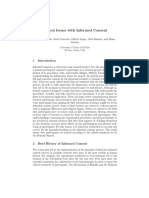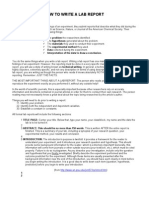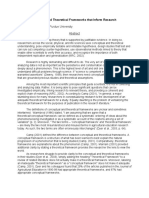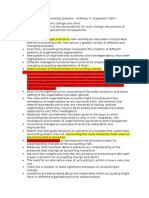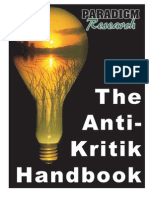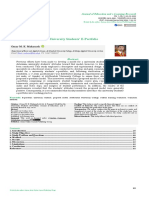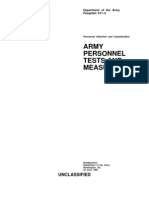Dissertation Outline
Dissertation Outline
Uploaded by
umchem2Copyright:
Available Formats
Dissertation Outline
Dissertation Outline
Uploaded by
umchem2Copyright
Available Formats
Share this document
Did you find this document useful?
Is this content inappropriate?
Copyright:
Available Formats
Dissertation Outline
Dissertation Outline
Uploaded by
umchem2Copyright:
Available Formats
Dissertation Outline
Title Page
Should contain at least the following:
DISSERTATION FOR THE UNIVERSITY OF LIVERPOOL
Title:
By: Student Name
(at the bottom of page)
Name
Student ID
Date:
Advisor:
Abstract
Generally the last thing written, the abstract should briefly tell the reader what the
dissertation is about. The student should summarise the key points of the document,
including the problem, the research question and the method. The maximum length for
a dissertation abstract is 350 words.
Table of Contents, List of Tables, Table of Figures
The Table of Contents and the List of Tables are best done using the facilities in Word.
Chapter 1: Aims of the Dissertation
The first section of the dissertation body should provide the introduction to the problem
to be addressed by the dissertation research. The problem statement may discuss
relevant literature as necessary to support the existence of the problem and/or provide
pertinent background information, but the literature review is the place for most of this
material. At the conclusion of the problem statement, the reader should have a clear
understanding of the problem to be addressed in the dissertation.
Chapter 2: Review of the Literature
This is an examination of the literature relevant to the dissertation problem, and the
problem statement should logically flow out of it. Ideally, all relevant research directly
bearing on the dissertation problem should be included, but the most important outcome
Research Methods Training Page 1 of 3
Copyright—Laureate Online Education © All rights reserved, 2000–2017. The Module, in all its parts—syllabus, guidelines, technical notes,
images and any additional material—is copyrighted by Laureate Online Education B.V. Last update: 14 December 2017
is that you do not directly repeat research that has been done already and that you
identify the theoretical basis of your work. Every effort should be made to include at
least some recent relevant literature.
Chapter 3: Methodology
The methodology section presents the details of the research process; it is the way or
ways you answer the problem specified in the aims section. Although the exact content
of this section will vary as a function of the nature of the particular research, the
methodology section should generally include the following topics:
1. Participants and/or sites: This will include detailed descriptions: who or what
they are; where they are located; why and how they were chosen; how access
will be obtained; ethical concerns regarding access such as confidentiality; when
and how often met with, etc.
2. Role of the researcher: This will include a detailed description of what
posture(s) you will take as a researcher, such as participant-observer, clinical
interviewer, etc. Address how these roles fit with the research questions and
theoretical framework, and how your prior experience, research or otherwise, will
affect the study in terms of researcher bias.
3. Data gathering or data generation techniques: You will include a detailed
rationale and descriptions of what was done, when, how, how long, why, etc.
4. Data analysis: You will describe the proposed analytic process, your rationale
for choosing it, and the various steps involved in it, whether graphical, statistical
or other.
5. Trustworthiness of the method: Discuss issues such as validity, reliability,
ethics, and ability to generalise. Discuss also the validity and reliability of the
data.
Chapter 4: Presentation of Results
This is where you explain the data you’ve collected—tables, summary of findings,
etc. Analysis goes in the next chapter.
Chapter 5: Analysis of Data
This is where your analysis of the data appears.
Chapter 6: Conclusions and Recommendations State what you can
conclude from the research, the implications of the results and what further research
would be advantageous.
Research Methods Training Page 2 of 3
Copyright—Laureate Online Education © All rights reserved, 2000–2017. The Module, in all its parts—syllabus, guidelines, technical notes,
images and any additional material—is copyrighted by Laureate Online Education B.V. Last update: 14 December 2017
References
References must be formatted using the Harvard system of referencing. The
Laureate library resource accessible from your desktop has all the detail you need
on this along with many other useful sources.
Appendices
The need for a dissertation to be documented completely to permit independent
replication usually requires the inclusion of appendices. Appendices typically contain
materials that help to explain what has been done but are either too bulky or too
tangential to incorporate in the text. The instructions given to the subjects, consent
forms and original instruments or questionnaires are some materials that may
appear in appendices.
Presentational Requirements
• You should print your own copy to keep and to verify that your document
prints appropriately. You do not need to submit a ‘hard’ paper copy to the
University. Submitting your dissertation in electronic format as a Word
document is the usual format.
• Referencing and text format must follow the Harvard citation style; the library
Web site has details of this.
• Times New Roman, Arial, or other easily readable fonts are acceptable.
Nonstandard typefaces or scripts are not acceptable.
• All text must be double spaced, except tables, which must be single-spaced.
• Font sizes should be 12 point for text and 10 point for footnotes.
• Style should be consistent throughout the document, including preliminaries,
end matter, table headings, figures and captions.
• There is no formal limit on file size, but you should use an appropriate
resolution. High-resolution photographs add little or nothing to academic
value, and you may be asked to produce a smaller version if you have
produced an unreasonable size of file. A file size of less than 2 megabytes is
usual.
Research Methods Training Page 3 of 3
Copyright—Laureate Online Education © All rights reserved, 2000–2017. The Module, in all its parts—syllabus, guidelines, technical notes,
images and any additional material—is copyrighted by Laureate Online Education B.V. Last update: 14 December 2017
You might also like
- Bronsteen's Writing A Legal Mem - John BronsteenDocument88 pagesBronsteen's Writing A Legal Mem - John BronsteenCecelia DoreenNo ratings yet
- Preparing Literature Reviews Qualitative and Quantitative ApproachesDocument4 pagesPreparing Literature Reviews Qualitative and Quantitative Approachesc5s4gda0No ratings yet
- LAWS1014 Reading Guide S1 2024Document64 pagesLAWS1014 Reading Guide S1 2024rachelNo ratings yet
- AACODS ChecklistDocument2 pagesAACODS ChecklistMattJigenAnoreNo ratings yet
- Course Syllabus - Community Based Participatory Research (CBPR) and Health Fall 2010Document8 pagesCourse Syllabus - Community Based Participatory Research (CBPR) and Health Fall 2010bonduranNo ratings yet
- Econ 306 SyllabusDocument6 pagesEcon 306 SyllabusVen DezelNo ratings yet
- Ethical Issues With Informed Consent (Escobedo, 2007) PDFDocument8 pagesEthical Issues With Informed Consent (Escobedo, 2007) PDFMuhammad YusarNo ratings yet
- Lecture 1 - Segal Chapter 1 & ConsequencesDocument37 pagesLecture 1 - Segal Chapter 1 & Consequencesapi-292402180No ratings yet
- General TheoryDocument263 pagesGeneral Theorystevecr13No ratings yet
- Memo Drawing File Folder Structure (R1)Document4 pagesMemo Drawing File Folder Structure (R1)umchem2No ratings yet
- 2010 - A Framework and Assessment Instrument For Information Security CultureDocument12 pages2010 - A Framework and Assessment Instrument For Information Security CultureTomNo ratings yet
- Purpose in Life Test CrumbaughDocument8 pagesPurpose in Life Test CrumbaughПламен МинчевNo ratings yet
- Predispositions of Quantitative and Qualitative Modes of InquiryDocument4 pagesPredispositions of Quantitative and Qualitative Modes of Inquirykinhai_see100% (1)
- Case StudiesDocument4 pagesCase StudiesmonsterbugsNo ratings yet
- Nature of The StateDocument5 pagesNature of The Stateapi-223744460No ratings yet
- Critically Reviewing The Literature ClassDocument32 pagesCritically Reviewing The Literature ClassSoman Rajpoot100% (1)
- 68-Phases in Research ProcessDocument6 pages68-Phases in Research ProcessShubham Amar SheteNo ratings yet
- A Review of The Literature On Case Study ResearchDocument13 pagesA Review of The Literature On Case Study Researchricardo_balau8081100% (1)
- Test Bank For Scientific American Environmental Science For A Changing World, 4e Susan Karr Test BankDocument24 pagesTest Bank For Scientific American Environmental Science For A Changing World, 4e Susan Karr Test BankNail BaskoNo ratings yet
- Dissertation Outline PDFDocument7 pagesDissertation Outline PDFEsperanza Para El Mejor100% (1)
- Practical Tips in Writing Thesis or DissertationDocument8 pagesPractical Tips in Writing Thesis or DissertationMa'am KC Lat Perez100% (1)
- Quantitive TechniqueDocument21 pagesQuantitive TechniqueNaveen JoshiNo ratings yet
- How To Write A Lab ReportDocument17 pagesHow To Write A Lab ReportDeimante BlikertaiteNo ratings yet
- The EthicDocument21 pagesThe EthicRafiq WafiyNo ratings yet
- 4 - Concenptual Framework 1Document3 pages4 - Concenptual Framework 1Choy Mun WeiNo ratings yet
- Ocd Research Essay 5Document10 pagesOcd Research Essay 5api-582025149No ratings yet
- Utilitarian Approach On AbortionDocument3 pagesUtilitarian Approach On Abortionbabayao10No ratings yet
- Research Methods - Unit 2Document23 pagesResearch Methods - Unit 2sirakNo ratings yet
- Descriptive Statistics PDFDocument23 pagesDescriptive Statistics PDFKARAN SINGH-MBANo ratings yet
- The Archaeology of Accounting Systems Anthony G Hopwood 1987Document4 pagesThe Archaeology of Accounting Systems Anthony G Hopwood 1987neomilanNo ratings yet
- Affirmative Action in American Law SchoolsDocument225 pagesAffirmative Action in American Law SchoolsBMX2013No ratings yet
- Theory Paper 1Document9 pagesTheory Paper 1api-527536953No ratings yet
- Research Sekaran UmaDocument22 pagesResearch Sekaran UmakmillatNo ratings yet
- Focus group discussions 1st Edition Hennink 2024 scribd downloadDocument81 pagesFocus group discussions 1st Edition Hennink 2024 scribd downloadbraffkleqkaNo ratings yet
- Research Design Literature ReviewDocument10 pagesResearch Design Literature Reviewakesh30No ratings yet
- Tertiary SourcesDocument55 pagesTertiary SourcesFranchesca LugoNo ratings yet
- How To Write An Analysis (With Examples and Tips)Document2 pagesHow To Write An Analysis (With Examples and Tips)Al Jairo KaishiNo ratings yet
- Asking Research Questions and Establishing The Significance of One'S ResearchDocument15 pagesAsking Research Questions and Establishing The Significance of One'S ResearchBonita TrogueNo ratings yet
- Apa 7 Ed. Quick Guide: American Psychological Association Website APA Style CentralDocument10 pagesApa 7 Ed. Quick Guide: American Psychological Association Website APA Style Centralmelfa julianti100% (1)
- Big Answer BookDocument208 pagesBig Answer BookAli Breland100% (1)
- Integrated Circuit - Wik..., The Free EncyclopediaDocument15 pagesIntegrated Circuit - Wik..., The Free EncyclopediaSuneelkrishna RallabhandiNo ratings yet
- Gettier Problem ProblemDocument23 pagesGettier Problem ProblemCharles MillerNo ratings yet
- Research Notes 1 PDFDocument18 pagesResearch Notes 1 PDFSekar MuruganNo ratings yet
- WE - Writing A Literature Review PDFDocument2 pagesWE - Writing A Literature Review PDFRonie Manic100% (1)
- Writing Your Psychology Research Paper Scott Baldwin Ebook All Chapters PDFDocument69 pagesWriting Your Psychology Research Paper Scott Baldwin Ebook All Chapters PDFrodazyounce100% (1)
- Dissertation StructureDocument2 pagesDissertation Structuremohammedakbar880% (1)
- Chapter 2Document26 pagesChapter 2Dinindu Siriwardene100% (1)
- HOw To Write Review1Document33 pagesHOw To Write Review1Dr.Neelam JainNo ratings yet
- Research Design Elements and TypesDocument9 pagesResearch Design Elements and TypesSMiley XeroxNo ratings yet
- Evolution of Project ManagementDocument14 pagesEvolution of Project ManagementSUSHANT S JOSHI100% (1)
- Brainstorming InventionDocument6 pagesBrainstorming InventionqmbutvxeNo ratings yet
- Chapter 6. Context-Oriented Research: Case StudiesDocument30 pagesChapter 6. Context-Oriented Research: Case StudiesEsra Teker KozcazNo ratings yet
- Structure and DiversityDocument261 pagesStructure and Diversityvicthor.plavitu100% (1)
- Faculty / Dept: Subject Number: Subject NameDocument9 pagesFaculty / Dept: Subject Number: Subject Namevanessa8pangestuNo ratings yet
- Quantitative and Qualitative Research: Based On Slides by DR Terry MaguireDocument39 pagesQuantitative and Qualitative Research: Based On Slides by DR Terry MaguireJohn O'NeillNo ratings yet
- Order Code 82419146 (Final)Document8 pagesOrder Code 82419146 (Final)Kreach411No ratings yet
- Senior Analytical Chemist in ST Louis MO Resume Patricia DoughertyDocument2 pagesSenior Analytical Chemist in ST Louis MO Resume Patricia DoughertyPatriciaDougherty100% (1)
- Research Methods in The Social SciencesDocument117 pagesResearch Methods in The Social SciencesTalo Contajazz ChilesheNo ratings yet
- Literature Review On Risk-Need-Responsivity Model: Basis For Program Development in Bureau of CorrectionsDocument17 pagesLiterature Review On Risk-Need-Responsivity Model: Basis For Program Development in Bureau of CorrectionsPsychology and Education: A Multidisciplinary JournalNo ratings yet
- Crime and Justice, Volume 42: Crime and Justice in America: 1975-2025From EverandCrime and Justice, Volume 42: Crime and Justice in America: 1975-2025No ratings yet
- Dissertation Advisor ProfilesDocument212 pagesDissertation Advisor Profilesumchem2No ratings yet
- Addendum 001Document2 pagesAddendum 001umchem2No ratings yet
- AE-May-2015-04-BS-7Document15 pagesAE-May-2015-04-BS-7umchem2No ratings yet
- Bed Alarms and Fall RiskDocument11 pagesBed Alarms and Fall Riskapi-253792021No ratings yet
- The Measurement of Place Attachment: Personal, Community, and Environmental ConnectionsDocument14 pagesThe Measurement of Place Attachment: Personal, Community, and Environmental Connectionsmeyyadeh alobaidiNo ratings yet
- A Proposed Model For The University Students' E-Portfolio: Omar M. K. MahasnehDocument6 pagesA Proposed Model For The University Students' E-Portfolio: Omar M. K. MahasnehAugustine DharmarajNo ratings yet
- University of Surrey: For The Service SectorDocument330 pagesUniversity of Surrey: For The Service SectorSri HarshaNo ratings yet
- Life Sciences Grade 10 Term 1 Week 1 - 2021Document10 pagesLife Sciences Grade 10 Term 1 Week 1 - 2021Chelain BoucherNo ratings yet
- Merluzzi 1997Document8 pagesMerluzzi 1997lolita putriNo ratings yet
- Guide To Teaching and Learning in Higher EducationDocument44 pagesGuide To Teaching and Learning in Higher Educationsajidriaz1No ratings yet
- Cattell, A Shortened Basic English Version Form of The 16 PF QuestionnaireDocument23 pagesCattell, A Shortened Basic English Version Form of The 16 PF QuestionnaireMr_ABNo ratings yet
- 2-Employee SelectionDocument26 pages2-Employee SelectionharpanbNo ratings yet
- Internet Banking Service QualiDocument25 pagesInternet Banking Service QualiNCaparri CagayanNo ratings yet
- Table of SpecificationDocument8 pagesTable of SpecificationWaqas Malik100% (3)
- Validity of The International Personality Disorder Examination (IPDE) Questionnaire On A Sample of Prison InmatesDocument6 pagesValidity of The International Personality Disorder Examination (IPDE) Questionnaire On A Sample of Prison InmatesMichael Stiven SolerNo ratings yet
- R Advance Assessment and Evaluation 2Document94 pagesR Advance Assessment and Evaluation 2Jerrick TomingNo ratings yet
- Employee Engagement As An Antecedent ToDocument9 pagesEmployee Engagement As An Antecedent ToNejash Abdo IssaNo ratings yet
- M1 - LLA - Research MethodologyDocument9 pagesM1 - LLA - Research MethodologyBekrar wiamNo ratings yet
- UNIT-3 Talent ManagementDocument24 pagesUNIT-3 Talent ManagementMradula YadavNo ratings yet
- Passis Test of CreativityDocument8 pagesPassis Test of CreativitySarah ShindeNo ratings yet
- Feben EshetuDocument59 pagesFeben Eshetumohammed jimjamNo ratings yet
- University Industry CollaborationDocument23 pagesUniversity Industry CollaborationLauraMilenaNo ratings yet
- REVIEWER Grade 10Document2 pagesREVIEWER Grade 10angeladmana09No ratings yet
- Roh Et Al (2022)Document11 pagesRoh Et Al (2022)Praveen AnaswaraNo ratings yet
- Research Ni Jake Na Kinulang KulangDocument9 pagesResearch Ni Jake Na Kinulang KulangJake BaldozaNo ratings yet
- Topic 8F Validity Reliability and Sources of ErrorDocument24 pagesTopic 8F Validity Reliability and Sources of ErrorCarleen Grace DeleonNo ratings yet
- HRM Quiz 4Document3 pagesHRM Quiz 4BernadetteNo ratings yet
- Functional Food: - A Study of Consumer Attitudes Towards Functional Foods in SwedenDocument66 pagesFunctional Food: - A Study of Consumer Attitudes Towards Functional Foods in SwedenBen ApawNo ratings yet
- Da Pam 385-1 - Small Unit Safety Officer GuideDocument122 pagesDa Pam 385-1 - Small Unit Safety Officer GuideMark CheneyNo ratings yet
- Understanding Data and Ways To Systematically Collect Data: Lesson 4Document32 pagesUnderstanding Data and Ways To Systematically Collect Data: Lesson 4Sam IntongNo ratings yet
- Generalizability: The Trees, The Forest, and The Low-Hanging FruitDocument6 pagesGeneralizability: The Trees, The Forest, and The Low-Hanging FruitDaniel PalmaNo ratings yet






